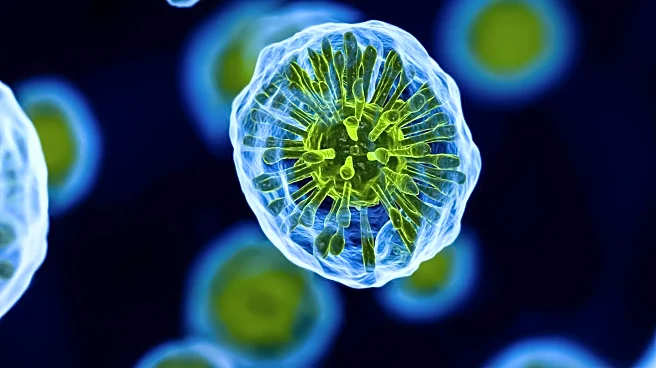What's Happening?
A team of researchers from University College London and Imperial College London has revealed how polymyxins, a class of last-resort antibiotics, disrupt the protective outer layer of harmful bacteria. The study, published in Nature Microbiology, shows that polymyxins cause rapid changes on the surface of E. coli cells, leading to the shedding of their protective armor. This process allows the antibiotic to penetrate and kill the bacteria. However, the study found that this mechanism is only effective when the bacteria are active, as dormant bacteria do not produce the armor, rendering the antibiotic ineffective. This discovery highlights the challenge of treating infections caused by dormant bacteria, which can survive unfavorable conditions and reawaken to cause recurrent infections.
Why It's Important?
The findings are significant in the fight against drug-resistant infections, which claim over a million lives annually. Understanding the mechanism of polymyxins provides insights into developing more effective treatments for bacterial infections, particularly those caused by Gram-negative bacteria. These bacteria are known for their resistance to many antibiotics, making them a major public health concern. The study suggests that combining polymyxin treatment with methods to activate dormant bacteria could enhance the antibiotic's effectiveness. This approach could lead to new strategies in combating persistent infections and reducing the impact of antibiotic resistance.
What's Next?
The research team plans to explore strategies to make polymyxins more effective by promoting armor production in dormant bacteria or waking them up before treatment. This could involve combining polymyxins with treatments that stimulate bacterial activity, allowing the antibiotic to target and eliminate dormant cells. Further research is needed to understand the conditions that trigger bacterial dormancy and how they can be manipulated to improve antibiotic efficacy. The study also emphasizes the importance of considering bacterial states when assessing antibiotic effectiveness, which could influence future drug development and treatment protocols.
Beyond the Headlines
The study raises ethical and practical considerations in antibiotic use, particularly in managing drug-resistant infections. It underscores the need for responsible antibiotic stewardship to prevent the emergence of resistance. Additionally, the research highlights the complexity of bacterial behavior and the importance of understanding microbial physiology in developing effective treatments. Long-term, these findings could influence public health policies and drive innovation in antibiotic research, potentially leading to breakthroughs in combating resistant infections.











